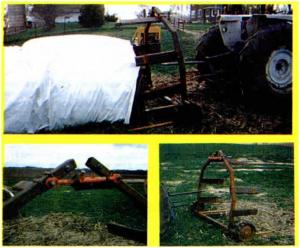Home-Built Bale Bagger
 ✖  |
"We've seen a lot of commercial-built bale baggers at farm shows that do exactly the same thing our home-built bagger does. The big difference is that factory-built units cost $4,000 or $5,000, while we put ours together for just $200 to $300," says Wayne Youngblom about a manually operated bale bagger he and his father, Warren, built last fall.
"We filled one 150-ft. bag with 26 5 1/ 2-ft. round bales of third cutting hay, which sometimes has spoilage problems, and we filled another with bales of corn stalks," Youngblom says. "It worked fine, eliminating the damage we normally would have from wet bales."
Youngblom's bagger is 9 ft., 3 in. wide and 7 ft. tall. The main frame and hinged uprights are made of 3 in. sq. tubing. Both uprights curve inward at a 30? angle to conform to the shape of bale.
Three 3-ft. long bag holders made of 8 1/ 4-in. wide flat iron attach with U-bolts to each upright. Two more bag holders extend backwards from the bottom of the frame.
After plastic is slipped onto the bag holders, the uprights are cranked outward by turnbuckles at the base of each upright. A "spreader" bar made from a 3 pt. hitch top link mounts between the top of the two up-rights to help apply tension to the plastic bag.
Braces behind each of the bagger's wheels keep it from moving when a bale is loaded into the bag. That's done manually by pulling the unit forward over bales held in position by a spear mounted on the Youngbloms' 6600 Ford tractor.
Contact: FARM SHOW Followup, Wayne Youngblom, 57488 160th St., Litchfield, Minn. 55355 (ph 612 693-3698 or 6503).

Click here to download page story appeared in.
Click here to read entire issue
Home-Built Bale Bagger CROP STORAGE Bag Silos 19-4-24 "We've seen a lot of commercial-built bale baggers at farm shows that do exactly the same thing our home-built bagger does. The big difference is that factory-built units cost $4,000 or $5,000, while we put ours together for just $200 to $300," says Wayne Youngblom about a manually operated bale bagger he and his father, Warren, built last fall.
"We filled one 150-ft. bag with 26 5 1/ 2-ft. round bales of third cutting hay, which sometimes has spoilage problems, and we filled another with bales of corn stalks," Youngblom says. "It worked fine, eliminating the damage we normally would have from wet bales."
Youngblom's bagger is 9 ft., 3 in. wide and 7 ft. tall. The main frame and hinged uprights are made of 3 in. sq. tubing. Both uprights curve inward at a 30? angle to conform to the shape of bale.
Three 3-ft. long bag holders made of 8 1/ 4-in. wide flat iron attach with U-bolts to each upright. Two more bag holders extend backwards from the bottom of the frame.
After plastic is slipped onto the bag holders, the uprights are cranked outward by turnbuckles at the base of each upright. A "spreader" bar made from a 3 pt. hitch top link mounts between the top of the two up-rights to help apply tension to the plastic bag.
Braces behind each of the bagger's wheels keep it from moving when a bale is loaded into the bag. That's done manually by pulling the unit forward over bales held in position by a spear mounted on the Youngbloms' 6600 Ford tractor.
Contact: FARM SHOW Followup, Wayne Youngblom, 57488 160th St., Litchfield, Minn. 55355 (ph 612 693-3698 or 6503).
To read the rest of this story, download this issue below or click
here to register with your account number.







